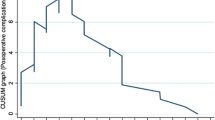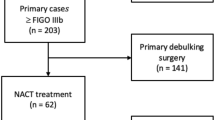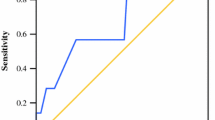Abstract
Objective
To evaluate whether the quantification of peritoneal metastases in advanced-stage ovarian cancer patients using the peritoneal carcinomatosis index, detected by CT (CT-PCI), correlates with the serum levels of tumor marker CA-125 and 5-year survival.
Methods
The CT-PCI was determined in 82 patients with stage III or stage IV ovarian cancer using the Sugarbaker classification prior to cytoreductive surgery. Linear regression analysis was used to correlate CT-PCI and CA-125 levels. Correlation of presurgical CT-PCI, optimal surgical cytoreduction, and 5-year survival was established using binary logistic regression analysis. A score for prediction of 5-year survival probability was established using multivariate backwards binary logistic regression.
Results
Presurgical CT-PCI correlates significantly with presurgical CA-125 serum levels (r = 0.487, P < 0.001). Multivariate binary logistic regression suggested significantly improved 5-year survival with lower CT-PCI and lower ECOG performance scores.
Conclusion
CT-PCI allows quantification of peritoneal disease in advanced-stage ovarian cancer patients, similar to CA-125. CT-PCI in combination with ECOG performance has the potential to help evaluate the 5-year survival probability.
Similar content being viewed by others
References
Jemal A, Siegel R, Xu J, Ward E (2010) Cancer statistics, 2010. CA Cancer J Clin 60(5):277–300. doi:10.3322/caac.20073
Clarke-Pearson DL (2009) Clinical practice. Screening for ovarian cancer. N Engl J Med 361(2):170–177. doi:10.1056/NEJMcp0901926
Meyer T, Rustin GJ (2000) Role of tumour markers in monitoring epithelial ovarian cancer. Br J Cancer 82(9):1535–1538. doi:10.1054/bjoc.2000.1174
Goff BA (2013) Advanced ovarian cancer: what should be the standard of care? J Gynecol Oncol 24(1):83–91. doi:10.3802/jgo.2013.24.1.83
Chornokur G, Amankwah EK, Schildkraut JM, Phelan CM (2013) Global ovarian cancer health disparities. Gynecol Oncol 129(1):258–264. doi:10.1016/j.ygyno.2012.12.016
Raja FA, Chopra N, Ledermann JA (2012) Optimal first-line treatment in ovarian cancer. Ann Oncol 23(Suppl 10):x118–127. doi:10.1093/annonc/mds315
Makar AP, Kristensen GB, Kaern J, et al. (1992) Prognostic value of pre- and postoperative serum CA 125 levels in ovarian cancer: new aspects and multivariate analysis. Obstet Gynecol 79(6):1002–1010
Sogaard CH, Lindegaard JC, Havsteen H, Nielsen OS, Mogensen O (2005) Chemotherapy-induced changes of CA 125 in patients with epithelial ovarian cancer. Gynecol Oncol 97(2):410–412. doi:10.1016/j.ygyno.2005.02.003
Tuxen MK, Soletormos G, Dombernowsky P (2001) Serum tumour marker CA 125 in monitoring of ovarian cancer during first-line chemotherapy. Br J Cancer 84(10):1301–1307. doi:10.1054/bjoc.2001.1787
Rossi AC, Di Vagno G, Cormio G, et al. (2004) A retrospective study of preoperative CA 125 levels in 82 patients with ovarian cancer. Arch Gynecol Obstet 269(4):263–265. doi:10.1007/s00404-002-0404-6
Wong C, Dai ZM, Lele SB, Natarajan N (2000) Comparison of CA 125 after three courses of chemotherapy and results of second-look surgery. Eur J Gynaecol Oncol 21(1):70–73
Gupta D, Lis CG (2009) Role of CA125 in predicting ovarian cancer survival—a review of the epidemiological literature. J Ovar Res 2:13. doi:10.1186/1757-2215-2-13
Cannistra SA (2004) Cancer of the ovary. N Engl J Med 351(24):2519–2529. doi:10.1056/NEJMra041842
Iyer VR, Lee SI (2010) MRI, CT, and PET/CT for ovarian cancer detection and adnexal lesion characterization. AJR Am J Roentgenol 194(2):311–321. doi:10.2214/AJR.09.3522
Mazzei MA, Khader L, Cirigliano A, et al. (2013) Accuracy of MDCT in the preoperative definition of peritoneal cancer index (PCI) in patients with advanced ovarian cancer who underwent peritonectomy and hyperthermic intraperitoneal chemotherapy (HIPEC). Abdom Imaging 38(6):1422–1430. doi:10.1007/s00261-013-0013-9
Sugarbaker PH, Jablonski KA (1995) Prognostic features of 51 colorectal and 130 appendiceal cancer patients with peritoneal carcinomatosis treated by cytoreductive surgery and intraperitoneal chemotherapy. Ann Surg 221(2):124–132
Kim HW, Won KS, Zeon SK, Ahn BC, Gayed IW (2013) Peritoneal carcinomatosis in patients with ovarian cancer: enhanced CT versus 18F-FDG PET/CT. Clin Nucl Med 38(2):93–97. doi:10.1097/RLU.0b013e31826390ec
Tentes AA, Tripsiannis G, Markakidis SK, et al. (2003) Peritoneal cancer index: a prognostic indicator of survival in advanced ovarian cancer. Eur J Surg Oncol 29(1):69–73
Dirisamer A, Schima W, Heinisch M, et al. (2009) Detection of histologically proven peritoneal carcinomatosis with fused 18F-FDG-PET/MDCT. Eur J Radiol 69(3):536–541. doi:10.1016/j.ejrad.2007.11.032
Dromain C, Leboulleux S, Auperin A, et al. (2008) Staging of peritoneal carcinomatosis: enhanced CT vs. PET/CT. Abdom Imaging 33(1):87–93. doi:10.1007/s00261-007-9211-7
Gryspeerdt S, Clabout L, Van Hoe L, Berteloot P, Vergote IB (1998) Intraperitoneal contrast material combined with CT for detection of peritoneal metastases of ovarian cancer. Eur J Gynaecol Oncol 19(5):434–437
Chandrashekhara SH, Thulkar S, Srivastava DN, et al. (2011) Pre-operative evaluation of peritoneal deposits using multidetector computed tomography in ovarian cancer. Br J Radiol 84(997):38–43. doi:10.1259/bjr/87415692
Duhr CD, Kenn W, Kickuth R, et al. (2011) Optimizing of preoperative computed tomography for diagnosis in patients with peritoneal carcinomatosis. World J Surg Oncol 9:171. doi:10.1186/1477-7819-9-171
Jacquet P, Sugarbaker PH (1996) Clinical research methodologies in diagnosis and staging of patients with peritoneal carcinomatosis. Cancer Treat Res 82:359–374
Chua TC, Al-Zahrani A, Saxena A, et al. (2011) Determining the association between preoperative computed tomography findings and postoperative outcomes after cytoreductive surgery and perioperative intraperitoneal chemotherapy for pseudomyxoma peritonei. Ann Surg Oncol 18(6):1582–1589. doi:10.1245/s10434-010-1492-3
Low CA, Bovbjerg DH, Jenkins FJ, et al. (2014) Preoperative inflammatory biomarkers and neurovegetative symptoms in peritoneal carcinomatosis patients. Brain Behav Immun 42:65–68. doi:10.1016/j.bbi.2014.06.019
Acknowledgments
We thank Jesaja K. Brinkmann for his help with data retrieval and preparation of CT images for publication.
Author information
Authors and Affiliations
Corresponding author
Ethics declarations
Conflict of interest
The authors declare that they have no conflict of interest.
Ethical approval
All procedures performed in studies involving human participants were in accordance with the ethical standards of the Partners Institutional Review Board (protocol number: 2012P001096) and with the 1964 Helsinki declaration and its later amendments or comparable ethical standards. For this type of study, formal consent is not required.
Additional information
The authors Daniel Diaz-Gil and Florian J. Fintelmann contributed equally to this work.
Rights and permissions
About this article
Cite this article
Diaz-Gil, D., Fintelmann, F.J., Molaei, S. et al. Prediction of 5-year survival in advanced-stage ovarian cancer patients based on computed tomography peritoneal carcinomatosis index. Abdom Radiol 41, 2196–2202 (2016). https://doi.org/10.1007/s00261-016-0817-5
Published:
Issue Date:
DOI: https://doi.org/10.1007/s00261-016-0817-5








